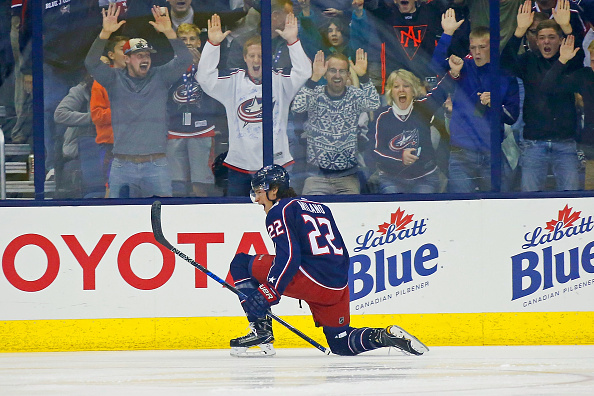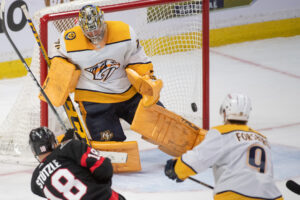NHL player development seems to always result in more questions than answers. How likely is it for a top pick to pan out? What makes a player a “steal”? Last Word On Hockey will be starting a new series on how to properly develop prospects from all different spots throughout the draft. This week’s piece involves draft picks in the back half of the first round and how they were used early in their careers.
NHL Player Development Of First-Round Picks
In the span of 2005 through 2015, there were 84 total selections made between 16th overall and 30th overall on forwards playing in North America. Looking at all 84 forwards, they were split into different categories. Those categories were “Forwards Deemed NHL-Ready and Brought In Immediately When Ready,” “Forwards Near NHL-Ready and Brought In Immediately When Near-Ready,” “Forwards Rushed Slightly,” “Forwards Rushed,” “Forwards Forced,” “A Little Patience,” “Patience,” and “Too Much Patience.”
There were 10 forwards who fell into the fifth category, “a little patience,” on the list. Of those 10 players, five made their NHL impacts in their DY+4 seasons. Those players were Nick Bjugstad, Vladislav Namestnikov, John Quenneville, Brock Nelson, and Sonny Milano. In this piece, we will look at Nelson and Milano.
In this piece, we will be using stats from EliteProspects (raw stats) and Hockey-Reference (ice time). Additionally, the analytics we are using are as follows: even-strength offence goals above replacement (EVO), even-strength defence goals above replacement (EVD), wins above replacement (WAR) and goals above replacement (GAR). Those analytics are from EvolvingHockey (subscription required).
NHL Player Development Of Brock Nelson
Nelson, drafted 30th overall in the 2010 NHL entry draft by the New York Islanders, came out of the US High School ranks with Warroad High in Minnesota. In his DY-1 season with Warroad High, Nelson scored 35 goals and 23 assists for 58 points in 25 games, for 2.32 points per game. That ranked third out of the aforementioned 84 forwards in DY-1 production. The following season, he would score 39 goals and 34 assists for 73 points in 25 games, for 2.92 points per game. That ranked second out of those same 84 forwards in DY production. Following the draft, he would go and play two seasons with the University of North Dakota in the NCAA, plus one season in the AHL, before getting into the NHL.
In his first NCAA season, Nelson scored eight goals and 13 assists for 21 points in 42 games, for 0.5 points per game. That ranked 77th out of the 82 forwards still outside the NHL in DY+1 production. The following season, Nelson scored 28 goals and 19 assists for 47 points in 42 games, for 1.119 points per game. That ranked 23rd out of the 70 forwards still outside the NHL in DY+2 production. Finally, he would make the jump to the professional ranks. Playing in the AHL with the Islanders affiliates, the Bridgeport Sound Tigers, Nelson scored 25 goals and 27 assists for 52 points in 66 games, for 0.788 points per game. That ranked 10th out of the 46 forwards still outside the NHL in DY+3 production.
How Nelson Was Used
Making the jump to the NHL for the first time, Nelson would see mostly NHL time. However, he would play one AHL game that season, scoring one assist. But that was it. He played 72 NHL games, and averaged 14:16 time on ice per game, a decent role. With it, he scored 14 goals and 12 assists for 26 points. A decent stat line, Nelson’s analytics painted a much better picture. Nelson would put up fantastic EVO (3.5) and EVD (4.8) scores as a rookie. Following those strong even-strength metrics, Nelson also had an excellent WAR (2.0) and GAR (10.8) for a rookie as well. Just an excellent underlying performance from the rookie Nelson.
In his second season, Nelson would play all 82 games at the NHL level, averaging 15:53 per game. With the increased role, he scored 20 goals and 22 assists for 42 points, a big step up from his rookie totals, but still not high-end. Analytically, his EVO (6.3) went up a bit, but his EVD (0.1) would drop quite a bit to nearly replacement level. Despite the step back defensively, his WAR (2.1) and GAR (10.8) was basically the same as his rookie year.
Nelson Takes Step Back In NHL Player Development
In his third NHL season, Nelson would play in 81 games and averaged 15:48 per game, which is almost an identical role as the year prior. With that, he saw almost the same production line. He scored 26 goals and only 14 assists for 40 points. Analytically, his EVO (6.0) took a small step back, while his EVD (-3.0) took a massive step back. With the continued decline in his defensive impacts, his WAR (0.6) and GAR (3.3) hit new lows.
After that third season, in 2015-16, Nelson would remain with the Islanders to this day. Playing in six full seasons and currently playing in his seventh since that third year, he has scored 154 goals and 143 assists for 297 points in 458 games with the Islanders in that span. So far this season, Nelson has 18 points in 17 games. He’s coming off his best season as well, where he scored 59 points in 72 games. Safe to say, the Islanders are very happy with the way Nelson has turned out, after drafting him straight out of high school. His NHL player development went as smoothly as one could ask, although he could have been better had he been able to build off his rookie season.
NHL Player Development Of Sonny Milano
Milano, drafted 16th overall in the 2014 NHL draft by the Columbus Blue Jackets, came out of the USHL with the US National Team Development Program. In his DY-1 season, Milano scored 10 goals and 12 assists for 22 points in 38 games, for 0.579 points per game. That ranked 55th out of the 84 forwards in DY-1 production. The following season, Milano scored 14 goals and 25 assists for 39 points in 25 games, for 1.56 points per game. That ranked 10th out of those same 84 forwards in DY production. After being drafted, Milano would leave the US development system and join the OHL’s Plymouth Whalers for a season, before playing in the AHL for two seasons until getting an extended look in the NHL.
In the OHL, Milano scored 22 goals and 46 assists for 68 points in 50 games, for 1.36 points per game. That ranked 17th out of the 82 forwards still outside the NHL in DY+1 production. Milano would then join the Blue Jackets AHL affiliates, the Lake Erie Monsters. With the Monsters, he scored 14 goals and 17 assists for 31 points in 54 games, for 0.574 points per game. That ranked 60th out of the 70 forwards still outside the NHL in DY+2 production. In his second AHL season, now with the Cleveland Monsters, the Jackets’ new affiliates, he scored 18 goals and 29 assists for 47 points in 63 games, for 0.746 points per game. That ranked 12th out of the 46 forwards still outside the NHL in DY+3 production. Finally, Milano would get an extended NHL look in his DY+4 season.
How Milano Was Used
Milano, after three-game and four-game NHL stints in the prior two seasons, would get a long look in his DY+4 season. Still playing some time in the AHL, he would score five points in nine AHL games. He would stick in the NHL for 55 games and averaged 11:39 per game. Milano scored 14 goals and eight assists for 22 points in that role. Analytically, he was decent, like his stat line displays. His EVO (2.3) and EVD (0.8) were good for a rookie, but not incredible. Meanwhile, his WAR (0.5) and GAR (2.8) reflected the same thing; good but not quite great.
The following season, Milano would see extreme regression. Playing mostly in the AHL (27 games, 24 points), he only saw eight NHL games and averaged just 8:19 per game. He scored just one goal. The sample being so small led to his analytics being dull. His EVO (0.4) and EVD (-0.2) were unimpressive. Additionally, his WAR (0.1) and GAR (0.7) were equally unimpressive.
Milano Makes NHL Return But Disappoints
Following a likely frustrating season, Milano would play exclusively in the NHL the very next year. He would get dealt mid-way to the Anaheim Ducks, and combined for 55 games played, with an average of 13:06 per game. Between the two teams, he scored seven goals and 16 assists for 23 points. Not bad, but not eye-opening either, like his rookie year. But his analytics were worse than his year one analytics were. His EVO (0.4) and EVD (-0.5) were lacklustre. His WAR (0.0) and GAR (-0.1) were extremely disappointing as well.
Following that third season, Milano would play 72 more games with the Ducks across two seasons, scoring 34 points, while playing three AHL games (three points) also in that span. Following the 2021-22 season, Milano would leave the Ducks and join the Washington Capitals for this season. So far, he has split between the AHL and NHL teams, playing five games at each level. In the AHL, he has three points, while he has produced four points in the NHL.
Milano, taken in the middle of the first, did not develop the way people had hoped. Granted, he had a really poor NHL player development path, thanks to the Blue Jackets. Going from the NHL to the AHL and back to the NHL, then to a new team is not easy to overcome. Additionally, he has always had limited ice time when at the NHL level, and that’s true with his new teams since leaving Columbus. While it’s not entirely the team’s fault, he was also dealt a tough hand as well.
Junior league stats via Elite Prospects, NHL stats via Hockey Reference, NHL analytics via Evolving Hockey
Main Photo:






